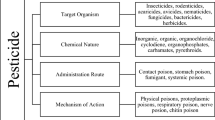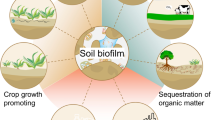Abstract
In the Xinjiang region of Eurasia, sustained long-term and continuous cropping of cotton over a wide expanse of land is practiced, which requires application of high levels of pyrethroid and other classes of pesticides—resulting in high levels of pesticide residues in the soil. In this study, soil samples were collected from areas of long-term continuous cotton crops with the aim of obtaining microbial resources applicable for remediation of pyrethroid pesticide contamination suitable for the soil type and climate of that area. Soil samples were first used to culture microbial flora capable of degrading beta-cypermethrin using an enrichment culture method. Structural changes and ultimate microbial floral composition during enrichment were analyzed by high-throughput sequencing. Four strains capable of degrading beta-cypermethrin were isolated and preliminarily classified. Finally, comparative rates and speeds of degradation of beta-cypermethrin between relevant microbial flora and single strains were determined. After continuous subculture for 3 weeks, soil sample microbial flora formed a new type of microbial flora by rapid succession, which showed stable growth by utilizing beta-cypermethrin as the sole carbon source (GXzq). This microbial flora mainly consisted of Pseudomonas, Hyphomicrobium, Dokdonella, and Methyloversatilis. Analysis of the microbial flora also permitted separation of four additional strains; i.e., GXZQ4, GXZQ6, GXZQ7, and GXZQ13 that, respectively, belonged to Streptomyces, Enterobacter, Streptomyces, and Pseudomonas. Under culture conditions of 37 °C and 180 rpm, the degradation rate of beta-cypermethrin by GXzq was as high as 89.84% within 96 h, which exceeded that achieved by the single strains GXZQ4, GXZQ6, GXZQ7, and GXZQ13 and their derived microbial flora GXh.







Similar content being viewed by others
References
Akbar S, Sultan S, Kertesz M (2015) Determination of cypermethrin degradation potential of soil bacteria along with plant growth-promoting characteristics. Curr Microbiol 70(1):75–84
Arora PK (2012) Decolourization of 4-chloro-2-nitrophenol by a soil bacterium, Bacillus subtilis RKJ 700. PLoS One 7(12):5682–5700
Caporaso JG, Kuczynski J, Stombaugh J, Bittinger K, Bushman FD, Costello EK, Fierer N, Peña AG, Goodrich JK, Gordon JI, Huttley GA, Kelley ST, Knights D, Koenig JE, Ley RE, Lozupone CA, McDonald D, Muegge BD, Pirrung M, Reeder J, Sevinsky JR, Turnbaugh PJ, Walters WA, Widmann J, Yatsunenko T, Zaneveld J, Knight R (2010) QIIME allows analysis of high-throughput community sequencing data. Nat Methods 7(5):335–336
Chen S, Hu M, Liu J, Zhong G, Yang L, Rizwan-ul-Haq M, Han H (2011a) Biodegradation of beta-cypermethrin and 3-phenoxybenzoic acid by a novel Ochrobactrum lupini DG-S-01. Journal of Hazard Materials 187(1–3):433–440
Chen S, Lai K, Li Y, Hu M, Zhang Y, Zeng Y (2011b) Biodegradation of deltamethrin and its hydrolysis product 3-phenoxybenzaldehyde by a newly isolated Streptomyces aureus strain HP-S-01. Appl Microbiol Biotechnol 90(4):1471–1483
Cunliffe M, Kertesz MA (2006) Effect of Sphingobium yanoikuyae B1 inoculation on bacterial community dynamics and polycyclic aromatic hydrocarbon degradation in aged and freshly PAH-contaminated soils. Environ Pollution 144(1):228–237
Cycoń M, Zmijowska A, Piotrowska-Seget Z (2014) Enhancement of deltamethrin degradation by soil bioaugmentation with two different strains of Serratia marcescens. Int J Environ Sci Technol 11(5):1305–1316
Dubey KK, Fulekar MH (2012) Investigation of potential rhizospheric isolate for cypermethrin degradation. Biotech 3(1):33–43
Grant RJ, Daniell TJ, Betts WB (2002) Isolation and identification of synthetic pyrethroid-degrading bacteria. J Appl Microbiol 92(3):534–540
Heuer H, Krsek M, Baker P, Smalla K, Wellington EM (1997) Analysis of actinomycete communities by specific amplification of genes encoding 16S rRNA and gel-electrophoretic separation in denaturing gradients. Appl Environ Microbiol 63(8):3233–3241
Janssen PH, Yates PS, Grinton BE, Taylor PM, Sait M (2002) Improved culturability of soil bacteria and isolation in pure culture of members of the divisions Acidobacteria, Actinobacteria, Proteobacteria, and Verrucomicrobia. Appl Environ Microb 68(5):2391–2396
Laffin B, Chavez M, Pine M (2010) The pyrethroid metabolites 3-phenoxybenzoic acid and 3-phenoxybenzyl alcohol do not exhibit estrogenic activity in theMCF-7 human breast carcinoma cell line or Sprague-Dawley rats. Toxicology 267(1–3):39–44
Lane DJ (1991) 16S/23S rRNA sequencing. Wiley, Chichester, pp 177–203
Li X, He J, Li S (2007) Isolation of a chlorpyrifos-degrading bacterium, Sphingomonas sp. strain Dsp-2, and cloning of the mpd gene. Res Microbiol 158(2):143–149
Lin QS, Chen SH, Hu MY, Haq MRU, Yang L, Li H (2011) Biodegradation of cypermethrin by a newly isolated actinomycetes HU-S-01 from wastewater sludge. Int J Environ Sci Tech 8(1):45–56
Magoč T, Salzberg SL (2011) FLASH: fast length adjustment of short reads to improve genome assemblies. Bioinformatics 27(21):2957–2963
Soderlund DM, Clark JM, Sheets LP, Mullin LS, Piccirillo VJ, Sargent D, Stevens JT, Weiner ML (2002) Mechanisms of pyrethroid neurotoxicity: implications for cumulative risk assessment. Toxicology 171:3–59
Tamura K, Dudley J, Nei M, Kumar S (2007) MEGA4: Molecular Evolutionary Genetics Analysis (MEGA) software version 4.0. Mol Biol Evol 24(8):1596–1599
Van Wijngaarden RP, Brock TC, Van den Brink PJ (2005) Threshold levels for effects of insecticides in freshwater ecosystems: a review. Ecotoxicology 14:355–380
Wang Q, Garrity GM, Tiedje JM, Cole JR (2007) Naive Bayesian classifier for rapid assignment of rRNA sequences into the new bacterial taxonomy. Appl Environ Microbiol 73(16):5261–5267
Xiao Y, Chen S, Gao Y, Hu W, Hu M, Zhong G (2015) Isolation of a novel beta-cypermethrin degrading strain Bacillus subtilis BSF01 and its biodegradation pathway. Appl Microbiol Biotechnol 99(6):2849–2859
Xiong J, Liu Y, Lin X, Zhang H, Zeng J, Hou J, Yang Y, Yao T, Knight R, Chu H (2012) Geographic distance and pH drive bacterial distribution in alkaline lake sediments across Tibetan Plateau. Environ Microbiol 14(9):2457–2466
Yen JH, Liao WC, Chen WC, Wang YS (2009) Interaction of polybrominated diphenyl ethers (PBDEs) with anaerobic mixed bacterial cultures isolated from river sediment. J Hazard Mater 165(1–3):518–524
Zengler K, Toledo G, Rappe M et al (2002) Cultivating the uncultured. Proc Natl Acad Sci U S A 99(24):15681–15686
Zhang C, Jia L, Wang S, Qu J, Li K, Xu L, Shi Y, Yan Y (2010) Biodegradation of beta-cypermethrin by two Serratia spp. with different cell surface hydrophobicity. Bioresour Technol 101:3423–3429
Zhang C, Wang S, Yan Y (2011) Isomerization and biodegradation of beta-cypermethrin by Pseudomonas aeruginosa CH7 with biosurfactant production. Bioresour Technol 102(14):7139–7146
Zhang W, Long X, Huo XD, Chen YF, Lou K (2013) 16S rRNA-based PCR-DGGE analysis of actinomycete communities in fields with continuous cotton cropping in Xinjiang, China. Microb Ecol 66(2):385–393
Acknowledgments
This work was supported by the Natural Science Foundation of Xinjiang Uygur Autonomous Region (Project No. 2014211A043)
Author information
Authors and Affiliations
Corresponding author
Additional information
Responsible editor: Robert Duran
Rights and permissions
About this article
Cite this article
Qi, Z., Wei, Z. Microbial flora analysis for the degradation of beta-cypermethrin. Environ Sci Pollut Res 24, 6554–6562 (2017). https://doi.org/10.1007/s11356-017-8370-5
Received:
Accepted:
Published:
Issue Date:
DOI: https://doi.org/10.1007/s11356-017-8370-5




